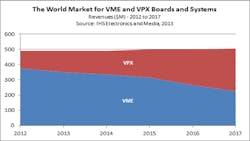It has now been ten years since the launch of a project to develop a new specification for critical embedded computing platforms. The objective of this project was to develop the specifications that would utilize various switched serial fabrics and targeted at platforms that would operate in rugged environments. This effort was started under the VITA 46 working group; quickly becoming commonly known as VPX. Since that time, much progress has been made on the specification. Many suppliers have products and systems are beginning early deployment.
The VITA VPX Marketing Alliance is 41 members strong and growing, with new companies joining the alliance on a regular basis. The alliance tracks the number of products in the VITA product directory as illustrated in Figure 1. There has been a steady and consistent increase in the number of products since the first products were introduced in 2007. This is not an all-inclusive list, but it is estimated to represent 60 to 70% of the products available worldwide. The variety of products span single board computers, signal processing, specialized IO, backplanes, chassis, and complete integrated systems ensuring that there are many good choices for system designers.
Growth Projections
VPX revenues were projected by industry analysts to match VME by 2012. This didn’t quite happen, as the cuts and uncertainty on military program spending went on longer than expected and is in fact still ongoing. New data from IHS Research shows the cross-over more likely to now occur in 2016 (Fig 2).
VPX has established a strong foothold in many defense programs that use high performance and rugged computing platforms. The defense sector represents about 80% of the revenue for VME and VPX combined. This could be even higher for VPX exclusively as the defense sector is the primary market at this time. In the early days of VMEbus it was just the opposite, most of the focus was on industrial and defense had no interest. Over time it will be interesting to see how other market sectors pick up on the VPX technology. Members of VITA are reporting VPX design wins in some transportation applications that can take advantage of the performance and rugged packaging.
Challenges
VPX has moved beyond the hype curve and is now in the ramping stage as programs using VPX-based platforms are starting early deployment. The specification is still being rounded out, with new capabilities being defined each year. The OpenVPX initiative to develop an architectural framework that defines interoperability of VPX components continues to evolve with new combinations added with each release, currently on the third such release. The architects working on this specification are starting to see some of the early shortfalls, making adjustments as needed to the framework document. Part of this work is to eliminate unused combinations that never were realized in the real world or that have been supplanted by better options. Continuing to evolve the OpenVPX architectural framework will remain a challenge for some time to come.
The ecosystem is also researching how to evolve to adapt optical interconnect technology that is emerging on the horizon. The VITA 66 Optical Interconnect on VPX specifications are the first fruits of the working group efforts. The first products implementing optical interconnections are just starting to show up in the market. Many technical challenges still remain but with the physical limitations of a copper interconnect, there are not a lot of good choices to handle the explosion of data that must be transported in the next generation of critical embedded computing platforms.
Fortunately, the fabric wars have settled down and the leaders have been established with Ethernet, PCI Express, Serial RapidIO, and the occasional InfiniBand implementation. There is sure to be new technology but for now, the suppliers are able to focus on product development with any of these fabrics with assurance that they can achieve a return on their investment.
The complexity of VPX systems has led to a higher level of integration than what was typically provided by VMEbus suppliers in the past. Even at the board level, many suppliers are offering a more complete solution or are teaming with other suppliers in the chain to increase the level of system integration. The leading suppliers in the industry, for instance, Mercury Systems and Curtiss-Wright Controls Defense Systems, are offering platforms that are near ready for deployment. Others, such as Elma Electronic or Kontron, offer systems and integration services to help reduce the integration challenge.
The Future
A category of computing called High Performance Embedded Computing (HPEC) is emerging. The use of switched serial fabrics makes it possible to interconnect systems in ways that lend themselves to the challenges of very high performance computing. VPX is establishing itself as a top solution for embedded platforms. The packaging density combines with the high performance levels to create some very interesting platforms, especially in signal processing applications that require a high number of computing blades.
VPX is expanding into new application areas. VITA 78 SpaceVPX Systems describes an open standard for creating high performance fault tolerant interoperable backplanes and modules to assemble electronic systems for spacecraft and other high availability applications. Such systems will support a wide variety of use cases across the aerospace community. This standard leverages the OpenVPX standards family and the commercial infrastructure that supports these standards in non-space applications.
There is still plenty of work ahead for the VPX ecosystem as both the technology and markets evolve and mature.



